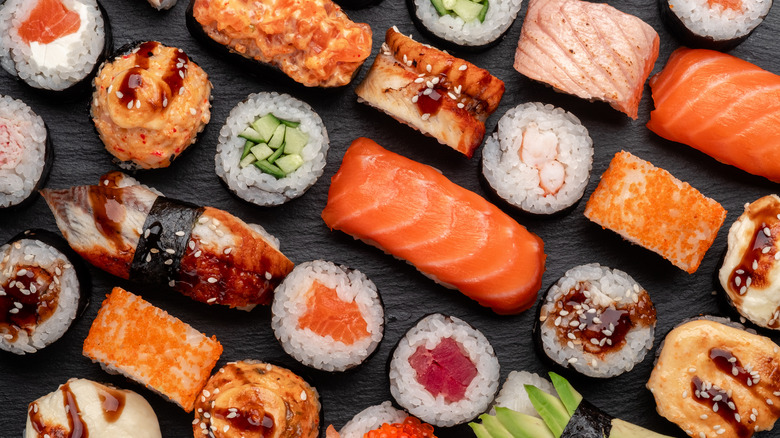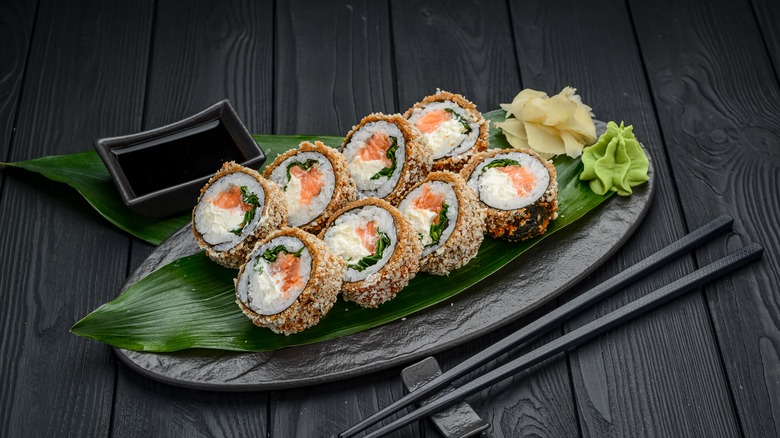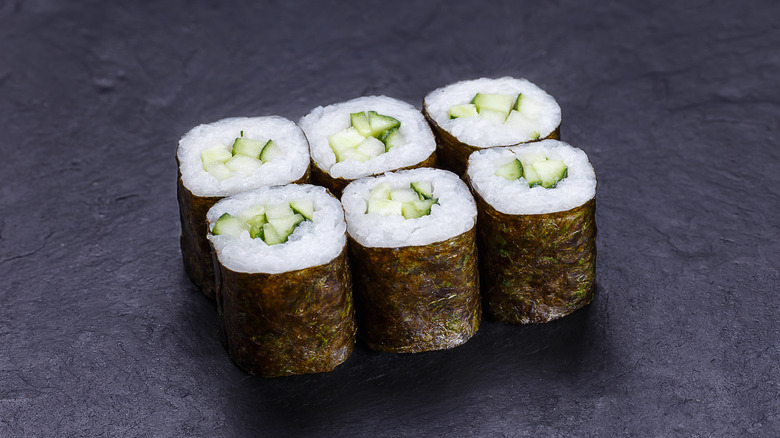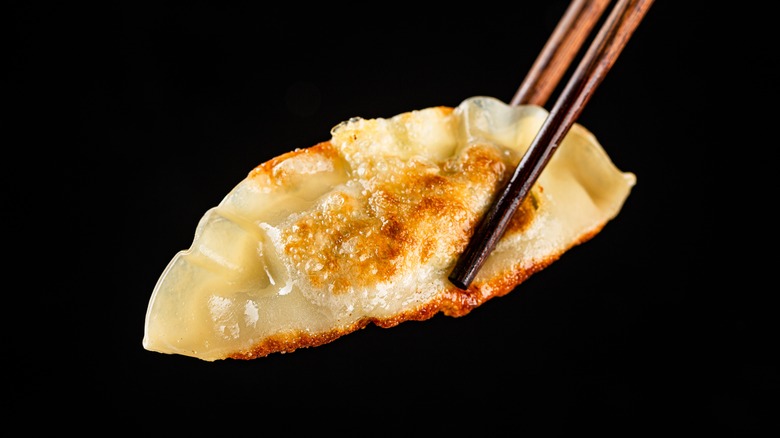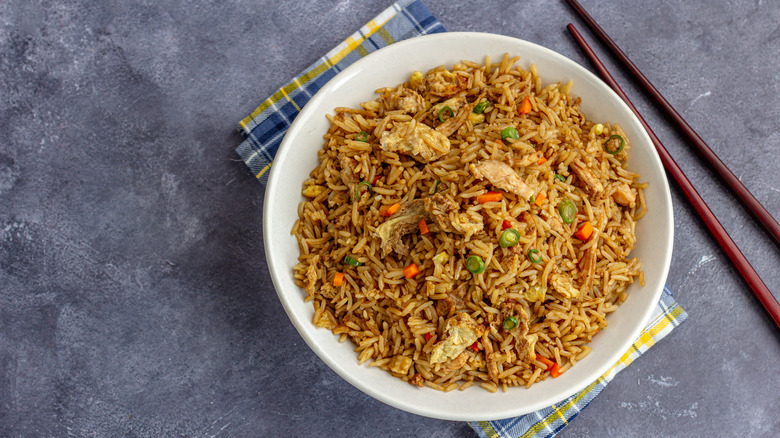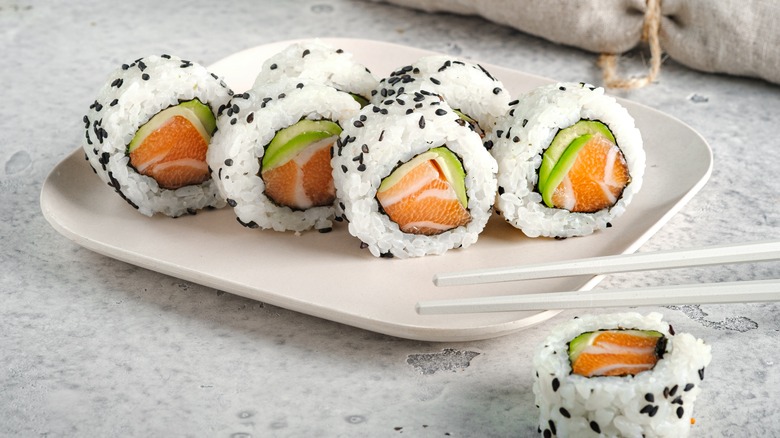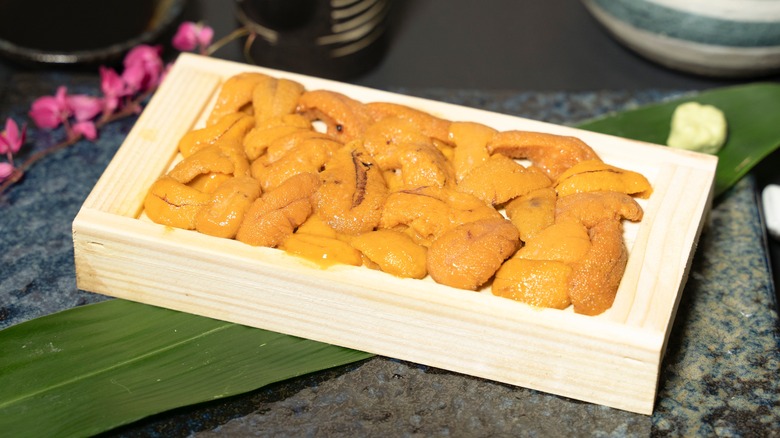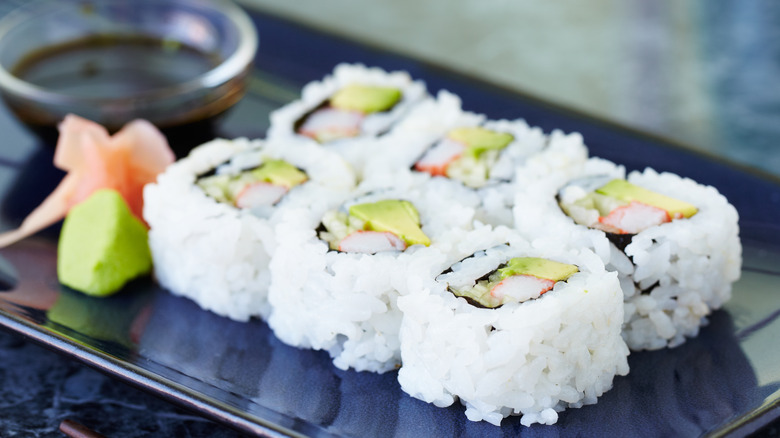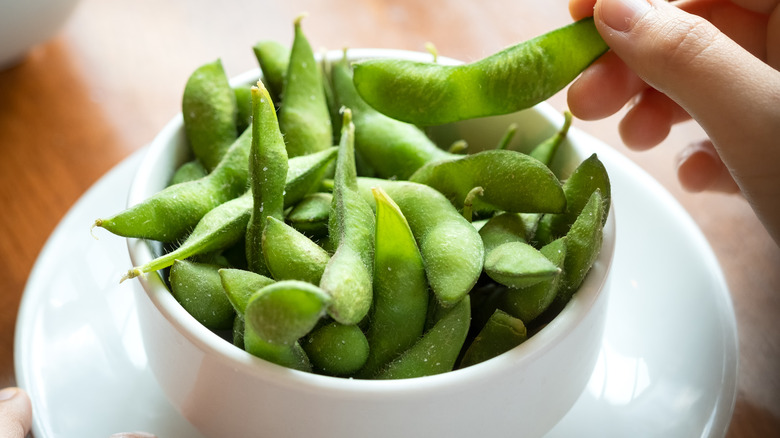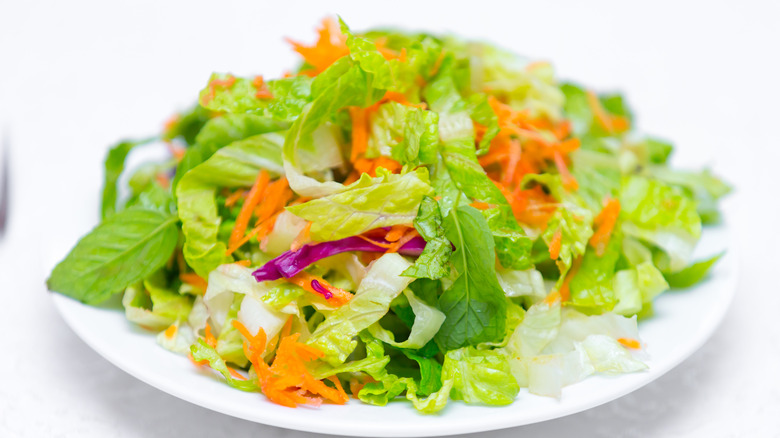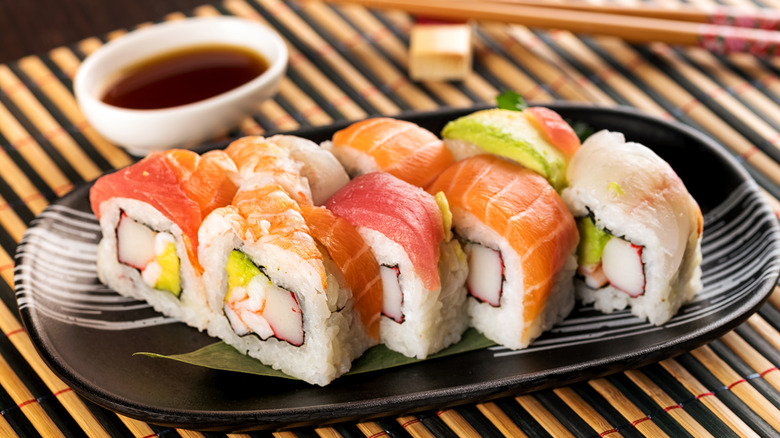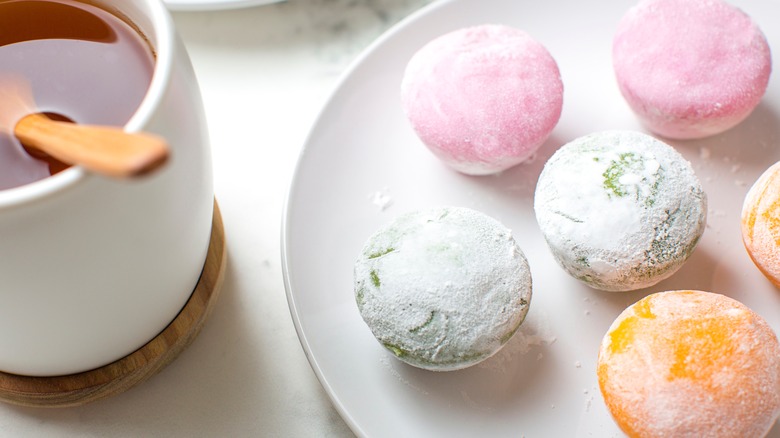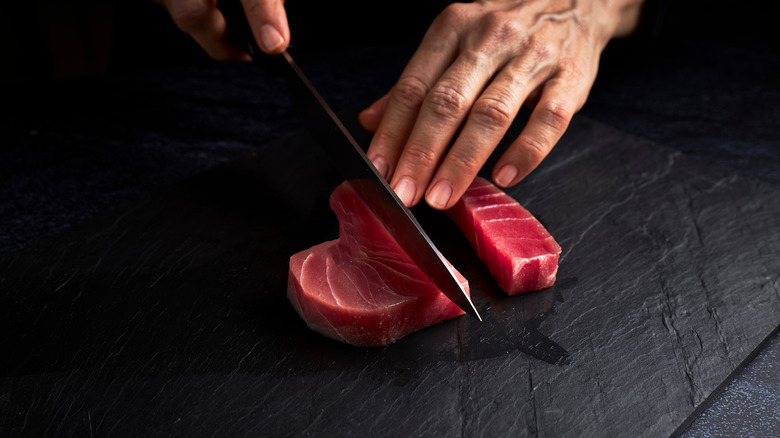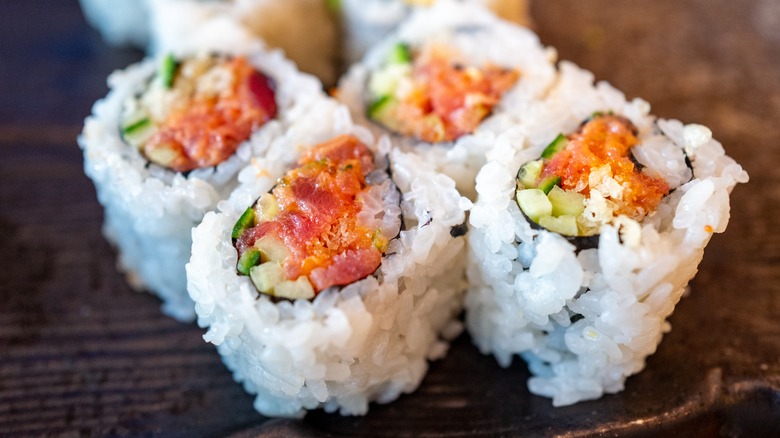14 Items To Avoid Ordering At A Sushi Restaurant
We love just about every kind of restaurant, but there's something about going out for sushi that feels extra special. Whether you're headed to a no-frills, casual spot or eating out at the best omakase restaurant in town, good sushi is characterized by its freshness, simplicity, and sophistication. But that doesn't mean that every dish you order at a sushi restaurant will be amazing. The truth some dishes are more likely than others to be lackluster, even at a high-quality restaurant. If you desire the best dining experience possible, you'll want to avoid the less interesting dishes and save room for the best bites on the menu.
We've compiled a list of the items we usually avoid when we go out for sushi, so you can start thinking about what you want to order the next time you find yourself at a sushi restaurant. These no-go dishes may or may not apply to your palate — if you love avocado in your sushi, go for it! However, they may just get you interested in trying a wider range outside your favorite types of sushi, and isn't that a good thing?
Rolls with cream cheese
Go to a sushi restaurant in Japan, and you're unlikely to find many options (or any options at all) that contain cream cheese — it's usually just not a common addition in Japan. Of course, you can opt for as much cream cheese in your sushi as you can reasonably digest if that's what you're into, but it's not one of our favorite ingredients. That's because the heavy creaminess of cream cheese distracts from the other flavors in the roll. And because sushi is largely about the fish, you ideally don't want to cover up too much of the flavor of the seafood. Additionally, cream cheese is usually pretty thick, which means it coats your mouth in a film of dairy, which can make it difficult to appreciate all of the other ingredients in a roll.
If you're looking for that filling, fatty flavor you love from cream cheese, you may want to opt for a fattier type of fish. A tuna is a good option, especially if you opt for a yellowtail. Hamachi, with its buttery texture, is another solid choice that tends to be less expensive than tuna.
Plain veggie rolls
Let's be clear here: Vegetarian sushi rolls can be delicious. There are so many incredible vegan sushi ingredients to choose from. When we say that you shouldn't order plain veggie rolls, what we really mean is that you shouldn't choose a roll with only with one type of vegetable inside. Often, these rolls are made with sliced cucumber, carrot, or radish, and unfortunately, they may be the only vegetarian-friendly sushi option on the menu.
Most of the time, these rolls tend to be bland and flavorless. You may be able to save them with generous use of soy sauce and wasabi, but if you have the choice, you should probably go with a more well-thought-out vegetarian option. A top-notch veggie sushi roll will incorporate multiple types of vegetables, and the best will also feature tofu or tempeh. It's possible that you'll pay more for this type of veggie roll, but it's worth it when you taste how well all the different flavors come together.
Gyoza
Just because you're going to a sushi restaurant doesn't mean you'll only find raw fish on the menu. Often, sushi restaurants feature other Japanese dishes, like gyoza. These dumplings can be filled with a wide variety of ingredients, from pork to cabbage, and they're often served both steamed and fried. Gyoza is a dish you should avoid ordering at a sushi restaurant largely because it's so filling. Eat just a few of the dumplings, and you'll likely find your appetite greatly diminished by the time your sushi comes out. And since sushi doesn't quite taste the same after you've taken your leftovers out of your fridge, that's not an ideal situation.
If you do decide to order the gyoza, you're better off going with the steamed version over the fried, as it'll be a bit lighter. Really set on the fried dumplings? Consider ordering your gyoza after your sushi. That way, you won't be ruining your appetite for the main part of the meal, and you can take the dumplings home if you have any leftovers. They tend to reheat better than fish.
Fried rice
Sometimes, you just want to eat food that's familiar and comforting. For many people, fried rice is one of those meals. But if that's really what you're craving, you probably shouldn't be at a sushi restaurant. At most sushi restaurants, fried rice is likely to be an afterthought: It's not the star of the show — that's a stickier variety of rice. Rather, since fried rice originated west of Japan, you're probably better off heading to a Chinese restaurant for it.
Making fried rice at home is also a relatively easy task, provided you already have the ingredients on hand. You can throw together an easy fried rice recipe with little more than some rice and a few vegetables, or you can go all out by adding ingredients like pork, eggs, or even kimchi, which will give your fried rice a beautiful bright orange color. Already have leftover rice in the fridge? It'll only take you a few minutes and a wok to whip up a plate of fried rice.
If you still want the fried rice as a shared side dish to enjoy with your sushi, go for it. But if it's all you plan on ordering, you have better fried rice options to choose from.
Anything with avocado
Just like you're unlikely to find cream cheese in many Japanese sushi restaurants, the same can be said for avocado — it's a Western sushi phenomenon. That certainly doesn't make it bad, but because it's fatty and thick, it distracts from the other flavors in your sushi roll. And considering that avocado tastes like very little at all, you don't really want it to flatten the nuance of high-grade fish. It also has a super creamy texture that doesn't meld well with the fleshiness of the fish and turns the chewy quality of rice too soft.
There's been a lot of hype around avocado as an ingredient for years, but that doesn't mean it should go into every single dish we eat. We love a good slice of avocado toast, and bright, acidic guacamole is one of the greatest culinary inventions in human history. But if you ask us, including avocado in a sushi roll is a crime.
Uni
Uni, or sea urchin roe, is considered a delicacy in Japan and other cuisines around the world. At its best, it's incredibly rich and creamy, lending a succulent and buttery flavor to any dish it's featured in. If you happen to be at a high-end sushi restaurant with a solid reputation, go ahead and order the uni — there's nothing better than the fresh, subtly flavored eggs.
However, when it comes to the majority of average sushi restaurants out there, ordering the uni is a risky endeavor. As good as uni can be when it's at its best, it can be so, so much worse when it's not fresh. Old uni takes on a distinct flavor of iodine that could make you question your whole dinner — and whether you even like uni in general. If you have any doubt in your mind, you're better off skipping the uni and opting for something else on the menu instead.
California roll
We've already discussed how much we dislike avocado in our sushi, so it shouldn't come as a surprise that we're not fans of the California roll. There are few rolls on any sushi menu that are as boring and bland as this one. Generally, a California roll contains crab, cucumber, and avocado. Sometimes, if you're lucky, your California roll will include actual crab meat. The majority of the time, though, you're going to get crab stick, or imitation crab, which is actually made out of a type of white fish and, if you ask us, doesn't taste like crab — or really anything — at all.
The other two ingredients included in a California roll are similarly flavorless: Avocado and cucumber aren't exactly known for their bold tastes. Sure, it may be a safe, familiar choice for some people, but don't be afraid to branch out and try something new. Nearly any other sushi roll will offer something more exciting than a California roll.
Tempura sushi
Fried food is one of life's greatest pleasures. It's fatty, it's crunchy, and it's deeply satisfying. Deep fry just about anything, and we're there for it. The one major exception to that rule is sushi. Don't get it wrong — tempura vegetables and seafood are love. But once you cover an entire sushi roll in batter and then deep fry it, the point of sushi — fresh fish — loses some of its appeal. Raw fish is light, fresh, and filling at the same time.
When you fry a sushi roll, the dish becomes a lot heavier. It's not usually what we look for when we go to a sushi restaurant. If you're going to order a tempura roll, you may want to consider opting for sushi that contains a tempura-fried ingredient rather than getting the entire thing coated. It will balance your roll, open different flavors, and not sit so heavily.
Edamame
Noshing edamame is one of our favorite ways to get protein. When it comes in its shell and is covered in flaky salt, it's a nutritious and energizing snack. When it's eaten on its own without the shell, it can add a fresh, green flavor to a wide variety of dishes. But is it the best thing to order at a sushi restaurant? We think not.
Sure, it's nice to have something to snack on while you're waiting for your sushi rolls to arrive, but you're probably going to pay a premium for that little bowl of beans at a sushi restaurant. Keep in mind that this is just plain steamed edamame — it's most often not prepped or cooked in any special way, just topped with salt and maybe paired with a mixed soy sauce. That means you could get the exact same dish at home for way less money. With today's food cost, that matters. Snack on a few pods before you head to the restaurant, and you can spend more money on the sushi itself.
Side salad
Ordering a side salad — at any type of restaurant — is a good way to ensure that you're getting enough vegetables into your diet, especially if you're enjoying a main course that's mostly focused on carbs and meat, as is the case with many kinds of sushi. Therefore, it may occur to you to get the side salad the next time you go to a sushi restaurant. If you're at a thoughtful, creative restaurant with an intentional menu, then a plate of veggies may be a good option. At a middle-of-the-road sushi joint, the side salad may be an afterthought.
If you ask us, that plastic bowl of iceberg lettuce, shredded carrots, and ginger sauce is just a distraction from the sushi. A love for ginger sauce is one of the exceptions for ordering the side salad. Otherwise, a seaweed salad is usually a better, more authentically flavorful option that plays alongside sushi.
Rainbow roll
If you're looking for the prettiest roll on the menu, you might be on the right track by ordering a rainbow roll. If your preference is for taste above appearance, you might want to skip it. Rainbow rolls feature raw fish not on the inside of the roll but sitting on top. The fish resting on top of the roll usually includes salmon, tuna, and yellowtail, and inside the roll, you'll find imitation crab, cucumber, and avocado.
So, yes, this is basically a California roll with some raw fish on top. We've already covered how we feel about California rolls — they are incredibly bland — so it should come as no surprise that we're not a fan of rainbow rolls either. Even though the addition of raw fish adds a nice, fresh touch to the dish, ultimately, it seems like this Western-style role is more about appearance than flavor. We'll have to pass.
Mochi
There are few desserts more glorious than mochi, the subtly sweet ice cream "cakes" made from mochigome, or sweet glutinous rice flour. Mochi comes in a wide variety of flavors, but it's really the texture that makes this dessert so special. It's chewy, cold, and creamy all in one bite. Try it once, and you'll be a mochi convert for life.
But if you're thinking about ordering it at a sushi restaurant, you may want to think twice. Most of the time, when you get mochi at a restaurant, it's normally a very small portion — probably a lot less than you'd enjoy if you were to serve yourself at home. To make matters worse, you're almost guaranteed to see a huge markup on that mochi if you get it from a restaurant. Considering it's so easy to grab a box of mochi at your local grocery store these days, we think it's a waste to order it at a sushi restaurant. Just keep some in the freezer to enjoy as much as you want when you get home.
Bluefin tuna
At many restaurants, especially if you're opting for an omakase experience, bluefin tuna, toro, is the star of the show. It's rich and fatty, with a clean, bright flavor that stands out when paired with rice. So, why shouldn't you order it from a sushi restaurant?
This suggestion comes down to sustainability, not taste. Because bluefin tuna is so popular that it has historically been overfished, threatening tuna populations around the world. This has led many to question whether it's actually a sustainable choice. Plus, because of the danger of overfishing, you're going to pay a premium for toro — even a single piece can set you back a pretty penny, especially if you're at an omakase restaurant. Otoro can range from $10 to $80 per piece.
Maybe you'll still want to order bluefin tuna from time to time when you truly feel like treating yourself. In this case, overfishing might not be such a concern for you since you're not eating it frequently. But, if you care about reducing overfishing at every meal, then the environmental cost is definitely not worth it, and you may want to avoid ordering bluefin tuna sushi.
Chopped fish spicy roll
When you order sushi, you want the freshest, highest-quality fish available. Most of the time, though, that's not what you get when you order a spicy chopped fish roll. That's because the fish they use to make this kind of roll is scraped, which is essentially all the leftover meat on the fish carcass after it's been processed. We're all for reducing food waste, but it's tough to know that the flavor of the fish is covered up with a spicy sauce because it's made from lesser cuts.
If you're looking for something that's on the spicier side, you should look for ingredients in your sushi that are naturally spicy. Sometimes, you might find jalapeño or chilis in a roll, both offering the tingling intensity you're going for. Wasabi can add some heat to your sushi as well, but just keep in mind that it's a different kind of spice than that you would get from hot pepper.
